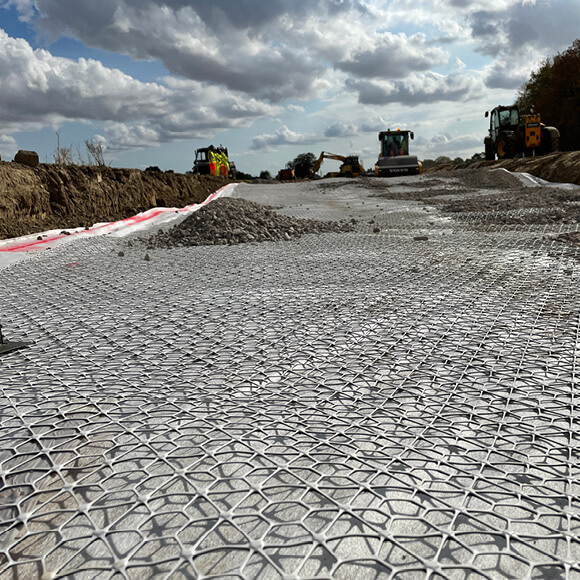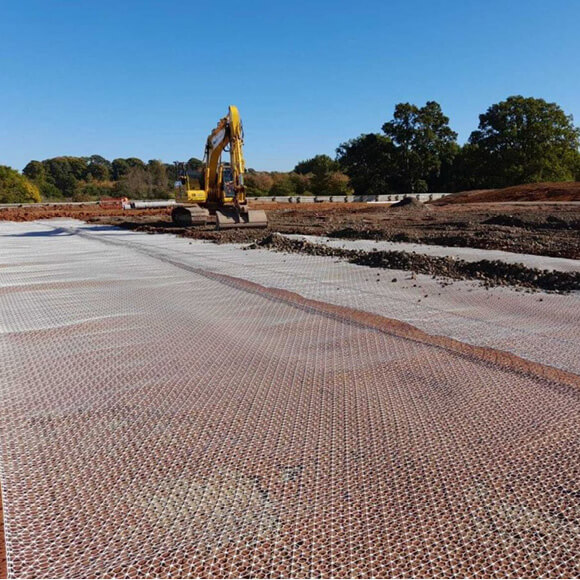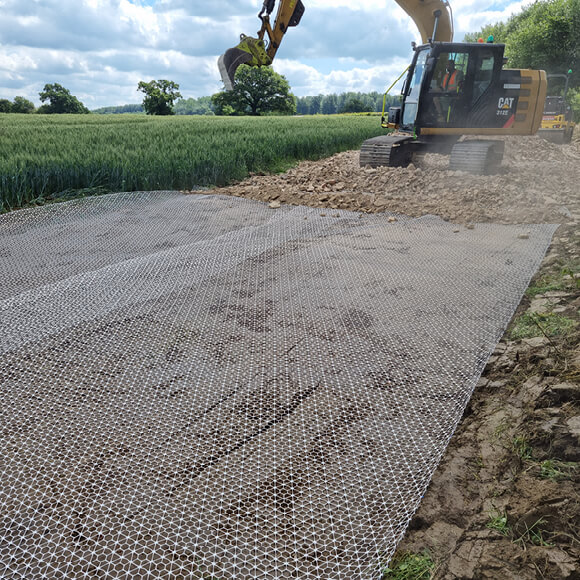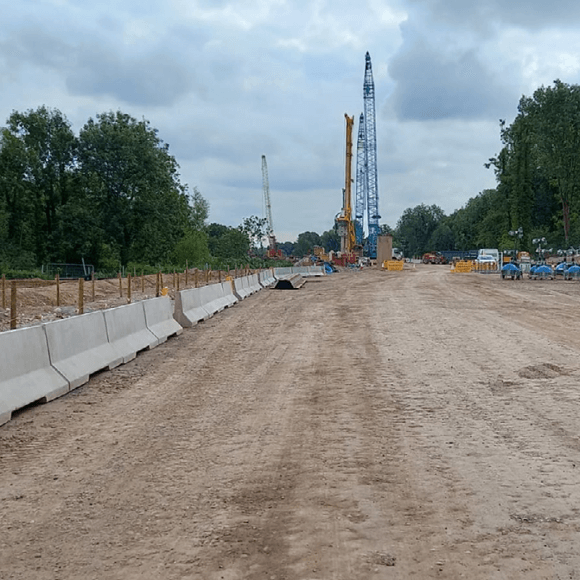Sustainable infrastructure emphasises the efficient use of finite resources, as well as the evaluation of the long-term economic, social, and environmental (ESE) impact of modern civil engineering projects. It is now widely accepted that the movement towards more eco-friendly infrastructure will play a pivotal role in tackling the climate crisis and delivering a lower carbon future – yet less well known is the value of geosynthetics in helping us to design and construct more environmentally friendly solutions.
Geosynthetic products such as geogrids offer design engineers the capacity to increase the sustainability of projects across a variety of different domains, from roads and railways to housing and renewable energy. This comprehensive Tensar guide explores sustainable infrastructure solutions involving geosynthetics, highlighting their importance in shaping more eco-friendly civil engineering practices and helping us to meet UN sustainability targets.
- Sustainability in infrastructure
- Reducing consumption of non-renewable resources with geosynthetics
- Climate change resilience with geosynthetics
- Meeting UN sustainability goals
- Tensar case study - Blockley STW Temporary Haul Road
- Tensar case study - HS2 Colne Valley Viaduct
- The Tensar difference
Ready to get started with using geosynthetics to meet your organisational sustainability goals? Contact us today.
Sustainability in infrastructure
What is sustainable infrastructure?
Sustainable infrastructure is designed with economic, social, and environmental impact in mind, and includes projects such as roads, housing, airports, and industrial works.
The core focus of sustainable infrastructure is on reducing the carbon impact of civil engineering work, conserving natural resources, fostering the use of renewable resources, and driving green economic growth that benefits the whole of society – not just select groups of people or organisations.
Why do we need to shift to more sustainable infrastructure?
Earth’s natural resources are limited and we must conserve them by minimising their use in the construction and maintenance of infrastructure.. The preservation of natural resources will help us to maintain an ecological balance, so that future generations can also meet their needs.
The construction sector is responsible for huge releases of carbon gases into the atmosphere. This carbon footprint has significantly contributed to climate change and the consequential geoenvironmental instabilities such as glacier melting, floods and sea-level rises worldwide.
Geosynthetics can play a major part when it comes to tackling the sustainability challenges geotechnical engineers face on a daily basis.
Reducing consumption of non-renewable resources with geosynthetics
What are geosynthetics?
Geosynthetics are synthetic materials that are used to improve the performance and durability of soil and rock in civil engineering applications by providing various functions, such as reinforcement, stabilisation, drainage, filtration, separation, protection, and barrier. Geosynthetics is a generic term that encompasses a range of products, such as geotextiles, geogrids, and geomembranes. Manufactured under controlled conditions, from a synthetic or natural polymer, in the form of a sheet, a strip or a three-dimensional structure, they are primarily designed for use in contact with soil or rock.
They can be an excellent addition to sustainable infrastructure projects, helping to conserve natural resources and energy, as well as reducing greenhouse gas emissions. Additionally, they can enhance the construction performance of soil and rock, improving strength and stability, and prolonging the service life of infrastructure. This comprehensive approach not only supports sustainability goals but also results in cost savings through reduced maintenance requirements and extended lifespan.
Geosynthetics manufacturers are continually evolving products and innovating to meet the changing needs of infrastructure projects. This includes the development of new materials and products with enhanced properties and functions, such as smart geosynthetics.

Tensar's InterAx geogrid reduces construction times and transportation requirements, as well as allowing for the use of thinner aggregate layers. An excellent addition to make infrastructure projects more sustainable.
Geosynthetics as resource-efficient solutions
Over the past 40 years, there has been a tremendous increase in the use of geosynthetics as the range of applications and design methods has grown and engineers have realised the benefits . Initially the benefits were measures in terms of construction cost and efficiency compared to traditional construction methods, but over time the environmental and life-cycle cost benefits have come to the forefront.
The benefits of using solutions incorporating geosynthetics, as alternatives to methods traditionally used in construction, can be divided into the immediate and long-term. Immediate benefits include the cost savings and sustainability gains from reductions in the volume of non-renewable materials and energy used, as well as faster construction times and lower transportation costs. In the longer term, whole-life cost savings and sustainability benefits related to performance, reliability, and reduced maintenance can be achieved.
Construction projects that incorporate geosynthetics solutions significantly reduce their consumption of natural aggregates such as sand and crushed rock. These materials are usually hauled over a long distance to the site, leading to high costs and carbon emissions associated with the transportation. In addition to reducing the volume of imported materials, geosynthetics may also allow for the reuse of on-site materials that would otherwise require off-site disposal, leading to even greater savings.
Geosynthetics such as geogrids are used in a range of infrastructure projects for improved sustainability. In infrastructure projects such as roads and railways, stabilisation geogrids can increase the bearing capacity and deformation resistance of the subbase, enabling a reduction in the thickness and cost of the pavement layers. Additionally, geogrids can provide a reinforcement function in earth retaining structures, reducing the volumes of concrete and foundation works needed.
Applications that achieve sustainability benefits from the use of geosynthetics include:

To facilitate the construction of a new road at North Heybridge, Tensar InterAx geogrid was utilised acheiving 80,000kg CO2e (57%) estimated reduction in environmental cost.
Combining geosynthetics and waste construction materials
For many years, the construction sector has sought to make use of waste materials such as ash and slags, mining waste, and construction and demolition waste.
By utilising waste materials in construction, as an alternative to primary sourced materials, consumption of non-renewable resources, energy, water and fuel, can all be drastically reduced. Recycled coarse aggregates produced from construction and demolition waste can reduce greenhouse gas emissions by 65% and save 58% of non-renewable energy consumption.
Geosynthetics enable the use of waste materials as an alternative to primary aggregates in a range of construction applications. Incorporating a stabilisation geogrid into a waste material can increase its strength and deformation resistance. Geogrid reinforcement enables some waste materials to be used as structural fill in reinforced soil structures for bridge abutments and retaining walls, and geotextiles can provide filtration and separation functions to enable certain waste products to be used in drainage applications and road foundations.
Environmental impact mitigation
There are several ways in which geosynthetic solutions can be incorporated into structures to reduce the impact on the environment both during construction and lifespan.
The use of geogrids to stabilise aggregate layers during road construction over soft subgrade enables a reduction in the thickness of the aggregate layers and enhances the performance of pavement. Geogrid stabilisation can avoid the need to remove and replace poor subgrade soils , which in turn leads to savings in costs and environmental impacts associated with transportation and disposal of spoil.
The use of geosynthetics with a separating and filtering function can replace natural aggregates, enabling cost savings compared to traditional drainage systems. In addition, they open the possibility of utilising lower-grade or re-cycled aggregates, saving on the use of non-renewable resources. Substituting gravel as a filtration layer with a geosynthetic solution has significant sustainability benefits
Geosynthetic materials acting as geosynthetic barriers offer a sustainable and durable alternative to traditional methods. In landfill for example, geomembranes can be used as a cover layer, preventing water infiltration and capturing biogas that can be used as a renewable energy source. Geomembranes are also for containment of liquid waste to prevent the migration of contaminants from leachate.

Tensar stabilised platform provides value for HS2 overbridge foundation with 100,000kg CO2e (75%) in estimated carbon emissions savings, 15 days (75%) estimated reduction in construction time and £250,000 (65%) estimated reduction in construction cost.
Geosynthetics and environmental conservation
Although geosynthetic materials can vary greatly in terms of function and application, they all possess characteristics that are important for sustainable development, such as the ease and speed with which geotechnical structures can be constructed, their durability and trouble-free operation as well as reducing the need for large construction sites.
A Life Cycle Assessment (LCA) is used to determine the true environmental impact of products and their use. Assessment covers all stages of a products life cycle, such as raw material extraction and processing, manufacturing, transportation, installation, maintenance, and end-of-life disposal or re-processing. Using life cycle assessment, twenty-five geosynthetics-based applications presented at the Geosynthetic Institute’s GRI-24 conference achieved an average of 65% reduction in carbon footprint compared to traditional solutions. The average carbon savings for individual case studies amounted to 69% for retaining walls, 65% for embankments and slopes, 76% for armouring, 75% for landfill covers, 30% for landfill liners, 61% for retention and 40% for drainage.
Climate change resilience with geosynthetics
The construction sector undoubtedly influences human-caused climate change and is a major contributor to greenhouse gas emissions (almost 40%), excavation and consumption of raw materials (50%), energy consumption (40%) and global waste production (30%).
With such a large environmental impact attributable to traditional construction methods, it is no surprise that sustainable infrastructure solutions such as geosynthetics have emerged. There is a certain irony given the negative impact of plastics on the environment in modern times that a specific family of plastic materials – namely geosynthetics – are helping protect it.
.jpg)
How geogrids contribute to climate resilience
One of the most common forms of geosynthetics are geogrids, whose numerous sustainability benefits include:
- Reduce the volume of non-renewable aggregates required for roads, railways, and other infrastructure.
- Extend road pavement service life and reduce life cycle cost of new roads
- Avoid the need to excavate, transport, and replace weak subgrade
- Extend the service life of asphalt overlays, reducing future maintenance.
- Enable the use of waste materials and on-site soils as structural fill.
- Speed up construction projects reducing overall costs and environmental
Invented in the late 1970s by Tensar founder Dr Frank Brian Mercer, Geogrids are commonly used in paved and unpaved road construction to reduce the volume of unbound aggregate materials used. In road pavements, geogrids are proven to increase the service life, reducing whole life cost. Used in asphalt overlays, geogrid interlayers control cracking and increase the service life of the overlay, reducing future maintenance. Soil structures incorporating geogrids as reinforcing elements, provide a more sustainable alternative to reinforced concrete retaining walls. These are just a few of the many sustainable construction solutions utilising geogrids. To learn more, see our article 'What role can plastics and geogrids play in sustainability?’.
.jpg)
The Viking Wind Farm in Shetland using floating roads incorporate Tensar geogrid. Tensar Geogrid's greatly reduced the hydrological impact on the surrounding peat and the volume of rock fill to be transported minimising environmental disruption.
Tackling climate change with geosynthetics
Climate change-induced global warming has raised global temperatures approximately 1.0 °C above pre-industrial levels, and if current rates are maintained, this will likely reach 1.5 °C between 2030 and 2052. The construction industry, as one of the larger producers of greenhouse gas emissions, has a huge responsibility to implement specific action plans to reduce emissions.
Geosynthetics make a major contribution to efforts to reduce construction related greenhouse gas emissions. This is achieved by offering solutions that reduce the volumes of aggregate and concrete needed in infrastructure construction compared to traditional methods.
Geosynthetics can also be used as solutions that offer resilience to the effects of climate change such as floods, droughts, and seal level rise. All over the world, increased variability and extremes in precipitation are having a destructive effect on infrastructure such as roads, railways, levees and earthworks. Geosynthetics can play a crucial role in providing climate change resiliency.
Stabilisation geogrids incorporated into road foundations mitigate against the effects of softened subgrade soils following floods or loss of permafrost, as well as controlling pavement cracks over expansive clay soils in periods of drought. Geogrid reinforced embankments can raise levees to protect against sea water level rise. Geosynthetic erosion products can protect soil slopes and drainage channels. These are just some of the geosynthetic solutions that increase resiliency against climate change effects.
Meeting UN sustainability goals
In 2015, all United Nations Member States adopted the 2030 Agenda for Sustainable Development which introduced and detailed the 17 Sustainable Development Goals (SDGs). Within these goals, there are 169 related targets that cover the three pillars of sustainable development - economic, social, and environmental.
The construction sector is affected by all 17 SDGs, most importantly SDG 6 (clean water and sanitation), SDG 7 (affordable and clean energy), SDG 9 (industry, innovation, and infrastructure), SDG 11 (sustainable cities and communities), SDG 12 (responsible consumption and production) and SDG 13 (climate action).
By using new technologies and materials such as geogrids and other geosynthetic products, civil engineers can significantly lower the environmental impact of their projects and achieve sustainability targets. Geosynthetics are also crucial in construction solutions that provide climate change resilience.
Tensar case study - Blockley STW Temporary Haul Road
A temporary haul road was to be constructed across arable farmland with low strength subgrade. At the end of the contract, all construction material has to be removed and the land handed back to the farmer. The requirement was the thinnest solution possible to reduce the amount of imported fill and vehicle movements through rural villages.
The solution was to design and construct a Tensar Mechanically Stabilised Layer (MSL) incorporating Tensar InterAx geogrid and SHW Series 600 6F2 recycled aggregate. As a result, a 32% reduction in construction cost, a 1.2 day reduction in construction time, along with a 47% (9,90kg CO2e) reduction in environmental cost was achieved.
This case study is a model example of how greenhouse gas emissions on construction projects can be drastically reduced in construction projects where the right type of geosynthetic solution is incorporated.
Visit our Blockley STW Temporary Haul Road case study to learn more, or our Tensar InterAx page to learn more about the geosynthetic used.

Tensar Mechanically Stabilised Layer (MSL) incorporating Tensar InterAx geogrid achieved a 32% reduction in construction cost, a 1.2 day reduction in construction time, along with a 47% (9,90kg CO2e) reduction in environmental cost was achieved.
Tensar case study - HS2 Colne Valley Viaduct
In this success story, Tensar provided an indemnified design service for temporary road sites and working platforms which in parts were close to existing lakes with shallow groundwater encountered. This meant that there was a need to limit excavation above the groundwater table and avoid exacerbating disturbance of sensitive subgrade soils to ensure construction proceeded smoothly.
The basis of Tensar’s road design was a mechanically stabilised aggregate layer that would support dynamic loads from repeated vehicle axle movements (stone delivery vehicles, concrete mixers) in addition to tracked plant that would be travelling along the site road between platforms. Where working platforms were located, additional static loading assessments were carried out for various rigs and crawler crane operations, utilising Tensar’s T-Value working platform design methodology to optimise the construction depth thickness.
This achieved a 40% saving in CO2e for working platform construction, 25,000m3 reduction of imported fill estimated for site works, 2,000 lorry movements taken off the road estimated from reduced import of quarried aggregates and £700,000 cost savings estimated against conventional stone only build-up.
Visit our HS2 Colne Valley Viaduct case study to learn more, or our Tensar TriAx page to learn more about the geosynthetic used.

Tensar Geogrid's achieved a 40% saving in CO2e for working platform construction, 25,000m3 reduction of imported fill estimated for site works, 2,000 lorry movements taken off the road estimated from reduced import of quarried aggregates and £700,000 cost savings estimated against conventional stone only build-up at HS2 Colne Valley Viaduct
The Tensar difference
Tensar offers proven, high-performance geosynthetic products, primarily including geogrids, that guarantee you can deliver your project with confidence. Not only do they provide significant sustainability benefits over alternative solutions, but they’re also widely accepted by road authorities worldwide and have had their performance proven and quantified by extensive research and field trials.
The range of geosynthetic products we offer includes:
- Tensar® InterAx® (NX) Geogrids
- Tensar® H-Series™ (HX™) Geogrids
- Tensar® TriAx® (TX) Geogrids
- Tensar® TriAx® (TX-G) Geocomposite
- Tensar® Uniaxial (RE) Geogrids
- Tensar® Basetex® Geotextile
Get in touch with us today to find out more, or explore more of our products on our solutions and their applications.


